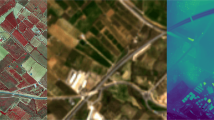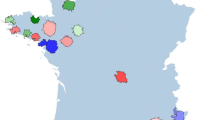Abstract
The field of GeoAI or Geospatial Artificial Intelligence has undergone rapid development since 2017. It has been widely applied to address environmental and social science problems, from understanding climate change to tracking the spread of infectious disease. A foundational task in advancing GeoAI research is the creation of open, benchmark datasets to train and evaluate the performance of GeoAI models. While a number of datasets have been published, very few have centered on the natural terrain and its landforms. To bridge this gulf, this paper introduces a first-of-its-kind benchmark dataset, GeoImageNet, which supports natural feature detection in a supervised machine-learning paradigm. A distinctive feature of this dataset is the fusion of multi-source data, including both remote sensing imagery and DEM in depicting spatial objects of interest. This multi-source dataset allows a GeoAI model to extract rich spatio-contextual information to gain stronger confidence in high-precision object detection and recognition. The image dataset is tested with a multi-source GeoAI extension against two well-known object detection models, Faster-RCNN and RetinaNet. The results demonstrate the robustness of the dataset in aiding GeoAI models to achieve convergence and the superiority of multi-source data in yielding much higher prediction accuracy than the commonly used single data source.










Similar content being viewed by others
Data availability
The datasets generated during and/or analysed during the current study will be made available in the GitHub repository, https://github.com/ASUcicilab/GeoImageNet.
Change history
25 January 2023
A Correction to this paper has been published: https://doi.org/10.1007/s10707-023-00488-3
References
Li K, Wan G, Cheng G, Meng L, Han J (2020) Object detection in optical remote sensing images: A survey and a new benchmark. ISPRS J Photogramm Remote Sens 159:296–307
Li W, Batty M, Goodchild MF (2020) Real-time GIS for smart cities. Int J Geogr Inf Sci 34(2):311–324
Li W, Arundel ST (2022) GeoAI and the future of spatial analytics. New thinking in GIScience. Springer, Singapore, pp 151–158
Gahegan M (2020) Fourth paradigm GIScience? Prospects for automated discovery and explanation from data. Int J Geogr Inf Sci 34(1):1–21
Li W (2020) GeoAI: Where machine learning and big data converge in GIScience. J Spat Inf Sci 2020(20):71–77
Zhang C, Sargent I, Pan X, Li H, Gardiner A, Hare J, Atkinson PM (2019) Joint Deep Learning for land cover and land use classification. Remote Sens Environ 221:173–187
Demertzis K, Iliadis L, Pimenidis E (2021) Geo-AI to aid disaster response by memory-augmented deep reservoir computing. Integr Comput Aided Eng 28(4):383–398
Li W, Zhou B, Hsu CY, Li Y, Ren F (2017) Recognizing terrain features on terrestrial surface using a deep learning model: An example with crater detection. In: Proceedings of the 1st Workshop on Artificial Intelligence and Deep Learning for Geographic Knowledge Discovery, pp 33–36
Zhao B, Feng J, Wu X, Yan S (2017) A survey on deep learning-based fine-grained object classification and semantic segmentation. Int J Autom Comput 14(2):119–135
Torres RN, Fraternali P, Milani F et al (2020) Mountain summit detection with Deep Learning: evaluation and comparison with heuristic methods. Appl Geomat 12:225–246. https://doi.org/10.1007/s12518-019-00295-2
Li W, Hsu CY (2020) Automated terrain feature identification from remote sensing imagery: A deep learning approach. Int J Geogr Inf Sci 34(4):637–660
Hsu CY, Li W (2021) Learning from counting: Leveraging temporal classification for weakly supervised object localization and detection. arXiv preprint arXiv:2103.04009
Yang Y, Newsam S (2010) Bag -of-visual-words and spatial extensions for land-use classification. In: Proc ACM SIGSPATIAL Int Conf Adv Geogr Inform Syst, pp 270–279
Sheng G, Yang W, Xu T, Sun H (2012) High-resolution satellite scene classification using a sparse coding based multiple feature combination. Int J Remote Sens 33(8):2395–2412
Cheng G, Han J, Lu X (2017) Remote sensing image scene classification: Benchmark and state of the art. Proc IEEE 105(10):1865–1883
Russakovsky O, Deng J, Su H, Krause J, Satheesh S, Ma S, …, Fei-Fei L (2015) Imagenet large scale visual recognition challenge. Int J Comput Vision 115(3):211–252
Everingham M, Van Gool L, Williams CK, Winn J, Zisserman A (2010) The pascal visual object classes (voc) challenge. Int J Comput Vision 88(2):303–338
Lin TY, Maire M, Belongie S, Hays J, Perona P, Ramanan D, ..., Zitnick CL (2014) Microsoft coco: Common objects in context. In: European conference on computer vision. Springer, Cham, pp 740–755
Razakarivony S, Jurie F (2015) Vehicle detection in aerial imagery: A small target detection benchmark. J Vis Commun Image Represent 34:187–203
Liu K, Mattyus G (2015) Fast multiclass vehicle detection on aerial images. IEEE Geosci Remote Sens Lett 12(9):1938–1942
Xia GS, Bai X, Ding J, Zhu Z, Belongie S, Luo J, Datcu M, Pelillo M, Zhang L (2018) DOTA: A large-scale dataset for object detection in aerial images. In: Proc IEEE Int Conf Comput Vision Pattern Recognit, pp 3974–3983
Arundel ST, Li W, Wang S (2020) GeoNat v1. 0: A dataset for natural feature mapping with artificial intelligence and supervised learning. Transactions in GIS 24(3):556–572
Goodchild MF, Guo H, Annoni A, Bian L, De Bie K, Campbell F, …, Woodgate P (2012) Next-generation digital earth. Proc Natl Acad Sci 109(28):11088–11094
Li W, Li L, Goodchild MF, Anselin L (2013) A geospatial cyberinfrastructure for urban economic analysis and spatial decision-making. ISPRS Int J Geo Inf 2(2):413–431
Tobler WR (1970) A computer movie simulating urban growth in the Detroit region. Econ Geogr 46(sup1):234–240
Arundel ST, Sinha G (2018) Validating the use of object-based image analysis to map commonly recognized landform features in the United States. Cartogr Geogr Inf Sci 46:441–455. https://doi.org/10.1080/15230406.2018.1526652
Azulay A, Weiss Y (2019) Why do deep convolutional networks generalize so poorly to small image transformations? J Mach Learn Res 20:1–25
Goodchild MF, Li W (2021) Replication across space and time must be weak in the social and environmental sciences. Proc Natl Acad Sci 118(35):e2015759118
Hsu CY, Li W, Wang S (2021) Knowledge-driven GeoAI: integrating spatial knowledge into multi-scale deep learning for Mars Crater detection. Remote Sens 13(11):2116
Wang S, Li W (2021) GeoAI in terrain analysis: enabling multi-source deep learning and data fusion for natural feature detection. Comput Environ Urban Syst 90:101715
Ren S, He K, Girshick R, Sun J (2015) Faster r-cnn: Towards real-time object detection with region proposal networks. In: Advances in neural information processing systems, pp 91–99
Lin TY, Goyal P, Girshick R, He K, Dollár P (2017) Focal loss for dense object detection. In: Proceedings of the IEEE international conference on computer vision, pp 2980–2988
Redmon J, Divvala S, Girshick R, Farhadi A (2016) You only look once: Unified, real-time object detection. In: Proceedings of the IEEE conference on computer vision and pattern recognition, pp 779–788
Hu Y, Gao S, Lunga D, Li W, Newsam S, Bhaduri B (2019) GeoAI at ACM SIGSPATIAL: progress, challenges, and future directions. SIGSPATIAL Special 11(2):5–15
Wang M, Deng W (2018) Deep visual domain adaptation: A survey. Neurocomputing 312:135–153
Xu W, He J, Shu Y (2020) Transfer learning and deep domain adaptation. In: Advances and Applications in Deep Learning. IntechOpen. https://doi.org/10.5772/intechopen.94072
Tong K, Wu Y, Zhou F (2020) Recent advances in small object detection based on deep learning: A review. Image Vis Comput 97:103910
Funding
This work is supported in part by the National Science Foundation under awards 2120943, 1853864, and 2230034.
Author information
Authors and Affiliations
Corresponding author
Ethics declarations
Conflict of interest
The authors declare that they have no conflict of interest.
Disclaimer
Any use of trade, firm, or product names is for descriptive purposes only and does not imply endorsement by the U.S. Government.
Additional information
Publisher’s note
Springer Nature remains neutral with regard to jurisdictional claims in published maps and institutional affiliations.
The original online version of this article was revised: The disclaimer statement was missing from this article and should have read "Any use of trade, firm, or product names is for descriptive purposes only and does not imply endorsement by the U.S. Government."
Rights and permissions
Springer Nature or its licensor (e.g. a society or other partner) holds exclusive rights to this article under a publishing agreement with the author(s) or other rightsholder(s); author self-archiving of the accepted manuscript version of this article is solely governed by the terms of such publishing agreement and applicable law.
About this article
Cite this article
Li, W., Wang, S., Arundel, S.T. et al. GeoImageNet: a multi-source natural feature benchmark dataset for GeoAI and supervised machine learning. Geoinformatica 27, 619–640 (2023). https://doi.org/10.1007/s10707-022-00476-z
Received:
Revised:
Accepted:
Published:
Issue Date:
DOI: https://doi.org/10.1007/s10707-022-00476-z




